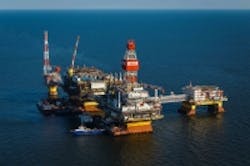Lukoil starts up V.Filanovsky in the Caspian Sea
Offshore staff
MOSCOW – Lukoil has started production from the Vladimir Filanovsky field in the Russian sector of the Caspian Sea.
The ultra-shallow water field, discovered in 2005, is Russia’s largest oil discovery of the past 25 years and the second field that Lukoil has commissioned in the Caspian Sea.
Estimated С1+С2 recoverable reserves under the Russian classification are 129 million tons of crude oil and 30 bcm of gas. At peak, the facilities should produce 6 MM tons/yr.
So far two horizontal production wells have been drilled, with flow more than 45,000 bbl combined, and a third well is under construction.
The sweet light crude is transported via a subsea pipeline to an onshore storage complex, then transferred to the Caspian Pipeline Consortium system for further exports.
Associated petroleum gas is transported to the gas processing unit at Lukoil’s Stavrolen plant for conversion into petrochemical products, for power generation purpose, and for Gazprom’s Unified Gas Supply System.
First-stage offshore facilities comprised the ISP-1 ice-resistant stationary platform; the LQP-1 living quarters platform, the CTP central treatment platform, the riser unit, and a subsea/onshore oil and gas pipeline system with a total length of more than 650 km (404 mi).
Shipyards in the Astrakhan region built the facilities. Lukoil has so far spent around 150 billion rubles ($2.37 billion) on the entire project.
To fully develop the field’s reserves and maximize peak production, a second stage is under way that involves fabrication of theISP-2 and LQP-2 platforms.
Vladimir Filanovsky is located in the northern Caspian Sea, 220 km (137 mi) from the city of Astrakhan, in water depths ranging from 7-11 m (23-36 ft).
Lukoil is implementing a “zero discharge” principle, and performing regular environmental monitoring including satellite monitoring of water, subsoil monitoring, pollution monitoring of the environment and wildlife resources.
10/31/2016
